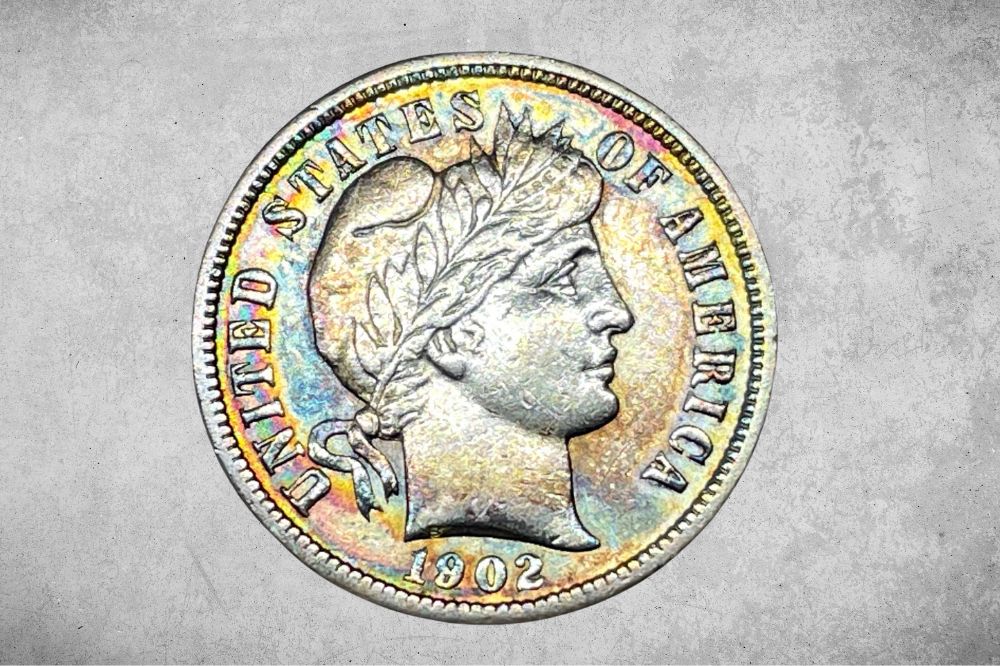Coins over 100 years old are extremely collectible, and the 1902 dime is no exception. While its age plays a major role in the value, there are many other details to consider that make each coin unique.
The value of a 1902 dime varies depending on coin condition, originating mint, and any errors that occurred during production. Current market value for these coins is between $2.83 and $425, but most 1902 dimes sell for thousands at auction.
We’ve put together this guide to explain why the difference in value is so great and how you can determine the general value of your 1902 dime. Keep reading to learn more about the coin’s different types, history, grading standards, and popular errors.
1902 Dime Details
- Category: Barber Dime (1892 to 1916)
- Mint: Philadelphia: New Orleans; San Francisco
- Mintage: 27,950,000
- Obverse Designer: Charles Barber
- Reverse Designer: Charles Barber
- Composition: 90% silver; 10% copper
- Fineness: 0.9
- Weight: 0.08818 oz
- ASW: .07234 oz
The 1902 dime features the same Barber obverse as the quarter and half dollar from that year paired with a modified dime reverse.
The front of the coin shows Lady Liberty facing right while wearing a Phrygian “Liberty” cap and a crown of olive branches. She also wears a ribbon across her head that reads LIBERTY at the front and ties at the back of her head.
The coin reads UNITED STATES OF AMERICA, with the inscription across the top curve of the coin and split by the top of her crown. The date is printed on the lower collar of the coin, along with a “B” for Barber.
The reverse reads the ONE DIME denomination in the middle, and it’s surrounded by a wreath of mixed materials. The upper right features two corn cobs, while the lower right hosts oak leaves and an acorn. The top left has wheat sheaves, while the lower features maple leaves.
The wreath is connected with a bow at the bottom, and the mint mark is printed below this bow. Both sides feature denticles around the rim.
1902 Dime Value Chart |
|||||
| Mint Mark | Good | Fine | Extremely Fine | Uncirculated | Proof |
| 1902 No Mint Mark Dime Value | $2.83 | $5.35 | $21.00 | $85.00 | / |
| 1902 O Dime Value | $3.30 | $12.00 | $53.00 | $286.00 | / |
| 1902 S Dime Value | $6.71 | $48.00 | $85.00 | $358.00 | / |
| 1902 Proof Dime Value | / | / | / | / | $425+ |
1902 Dime Value and Varieties Guide
There are 3 varieties of the 1902 dime, and all three command a premium over their face value due to the rarity of the coin.
This particular year is not remarkably collectible. The Barber coinage is not a favorite of collectors, but 1902 is set far enough in the past to make higher-grade coins much more valuable.
1902 No Mint Mark Dime Value
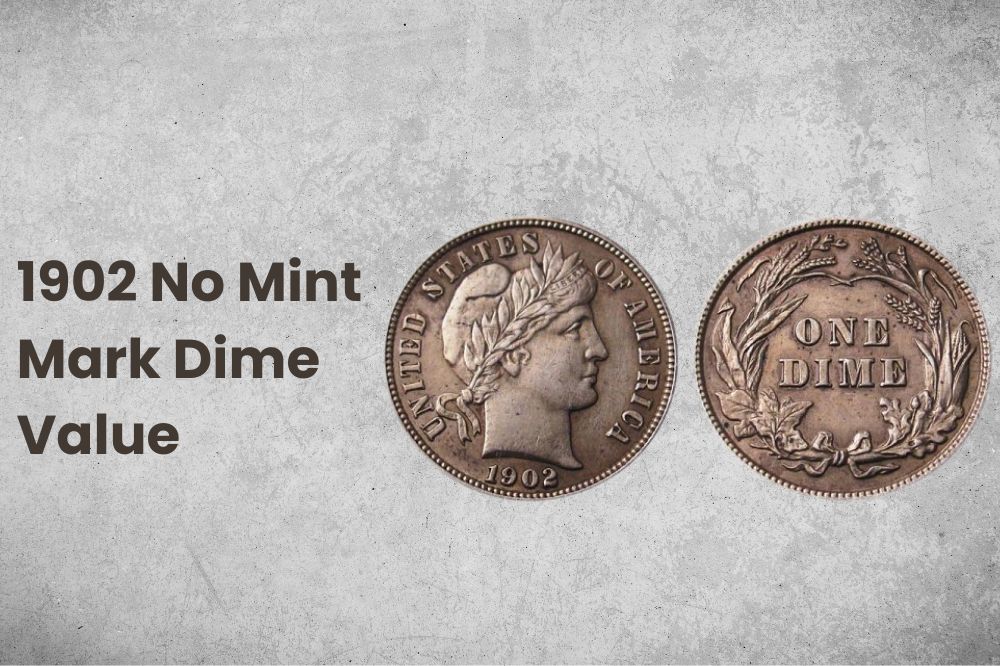
- Type: Barber Dime (1892 to 1916)
- Edge: Reeded
- Mint Mark: N/A
- Place of Minting: Philadelphia
- Year of Minting: 1902
- Face Value: $0.10
- $ Price: $2.83 to $85+
- Quantity Produced: 21,380,000
- Designer: Charles Barber
- Mass: 2.50 grams
- Diameter: 17.90 mm
Philadelphia saw a smaller number of Barber dimes produced in 1902. Coins from this area at this time are often kept in better condition at greater numbers, and they command a smaller premium at all grades.
This is why the no mint mark 1902 dime only regularly values between $2.83 and $85, depending on grade. Despite this, auctions have seen this coin sell for as much $5,875 for a PCGS MS-67 1902 dime.
1902 O Dime Value
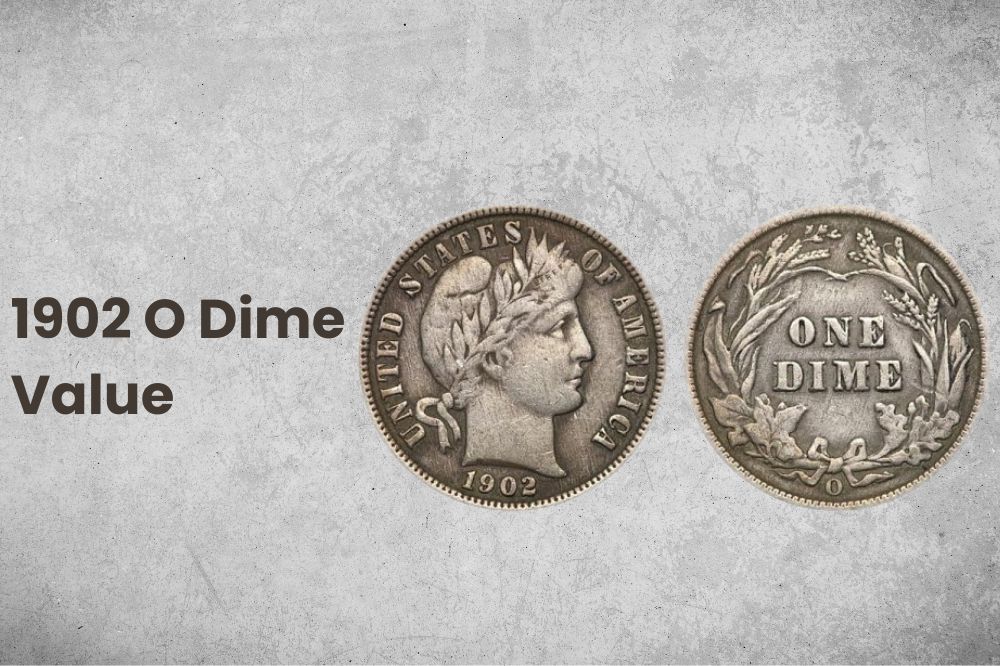
- Type: Barber Dime (1892 to 1916)
- Edge: Reeded
- Mint Mark: O
- Place of Minting: New Orleans
- Year of Minting: 1902
- Face Value: $0.10
- $ Price: $3.30 to $286+
- Quantity Produced: 4,500,000
- Designer: Charles Barber
- Mass: 2.50 grams
- Diameter: 17.90 mm
The New Orleans mint produced several gold and silver coins in its many years of operation, including the majority of the 1902 dimes. With about 4.5 million dimes rolling out of the mint, they’re a popular coin for collection.
The New Orleans mint struck its coins well, and many 1902 dimes with an O mark are still in fine or better condition. They regularly sell for $3.30 in “Good” condition, but “Uncirculated” coins can go for $286 or greater.
The auction record belongs to a NGC MS-67 1902 O dime that sold for $12,650 in a 2007 Heritage Auction.
1902 S Dime Value
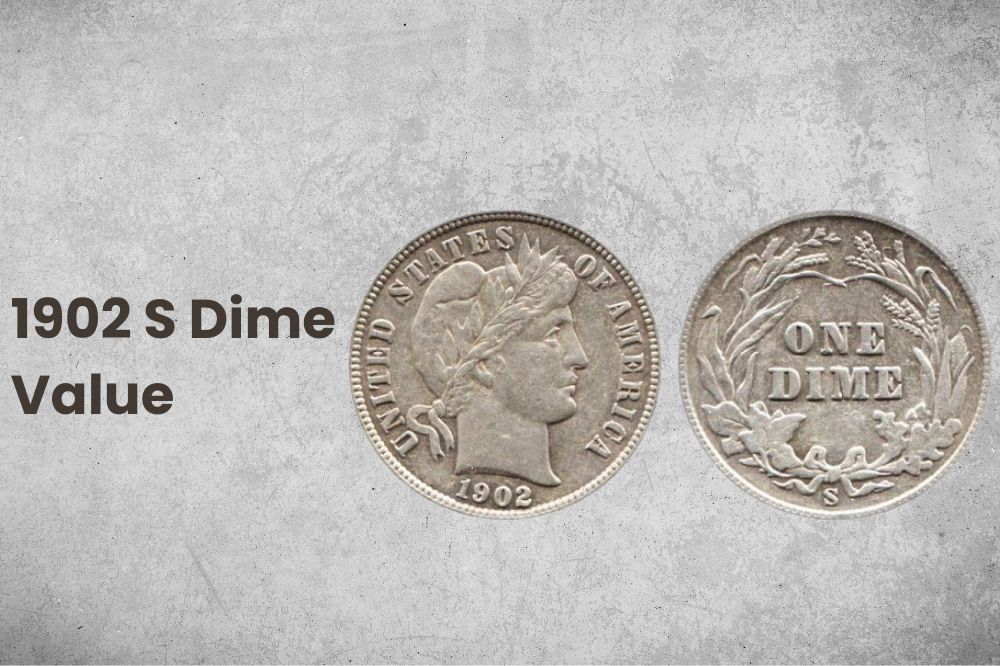
- Type: Barber Dime (1892 to 1916)
- Edge: Reeded
- Mint Mark: S
- Place of Minting: San Francisco
- Year of Minting: 1902
- Face Value: $0.10
- $ Price: $6.71 to $358+
- Quantity Produced: 2,070,000
- Designer: Charles Barber
- Mass: 2.50 grams
- Diameter: 17.90 mm
The San Francisco mint produced fewer coins in 1902 than it did in the proceeding years. The city had experienced a tragic earthquake (and subsequent fires) in the previous year, and nearly $30,000 in gold coins were also stolen that year.
Because the mint was still recovering from these tragedies, the smaller production of coins in 1902 are worth more than those from other mints. A 1902 S dime sells for about $6.71 in “Good” condition, while “Uncirculated” coins regularly sell for $358 or greater.
A Legend Rare Coin Auction saw the record for this particular coin in 2014 when a PCGS MS-67+ 1902 S dime sold for $21,150.
1902 Proof Dime Value
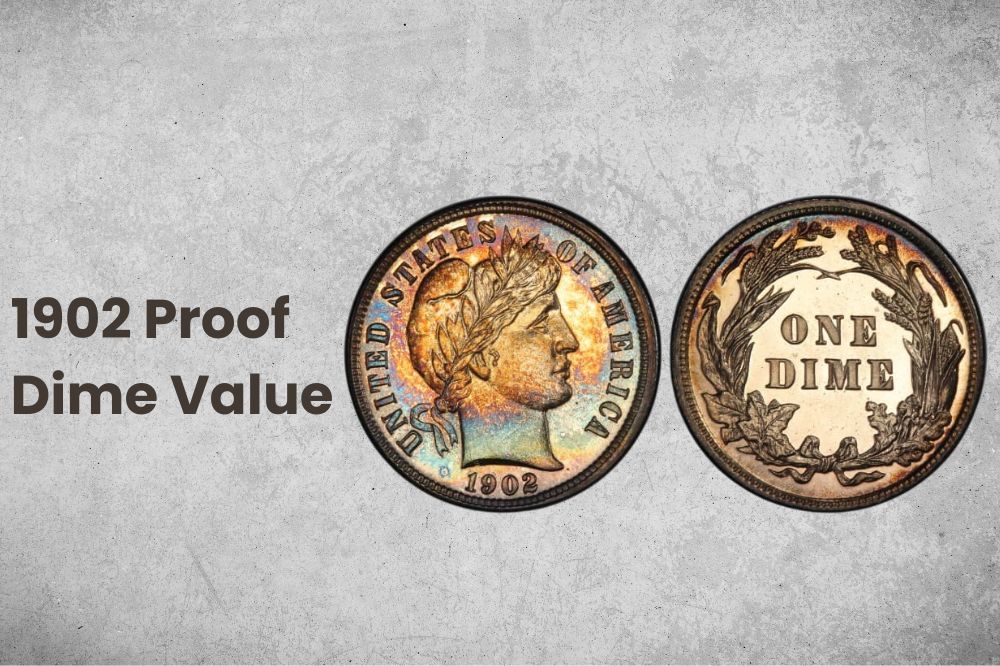
- Type: Barber Dime (1892 to 1916)
- Edge: Reeded
- Mint Mark: N/A
- Place of Minting: Philadelphia
- Year of Minting: 1902
- Face Value: $0.10
- $ Price: $425+
- Quantity Produced: 777
- Designer: Charles Barber
- Mass: 2.50 grams
- Diameter: 17.90 mm
Philadelphia produced an extremely limited number of proof dimes in 1902. They were made for investment and collection purposes, and these particular coins have strong details and attractive features.
Like all Philadelphia coins, the 1902 proof dime does not bear a mint mark, but its reflective field is a key indicator of coin type. A professional grades these coins as “PF” or “PR” and they sell for $425 in an open market, but often more.
The current auction record was sold in a 2008 Heritage Auction. The NGC PR-61 1902 proof dime is a lower grade than you usually see proofs, but it sold for $17258.
Also Read: Top 15 Most Valuable Roosevelt Dimes Worth Money
1902 Dime History
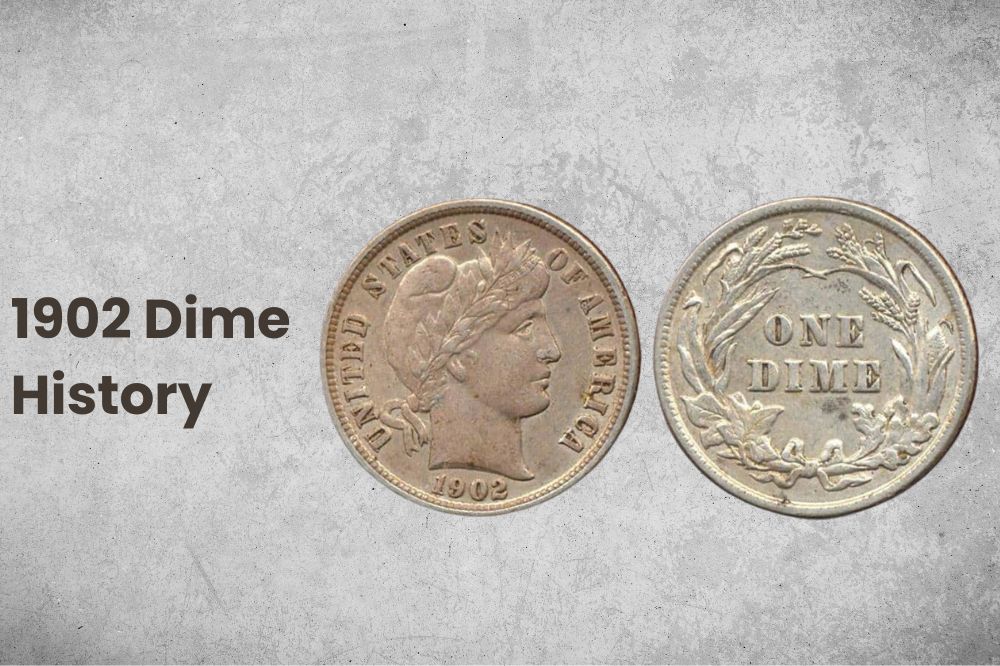
The 1902 dime is part of the Barber coinage set, and it shares its obverse design with the quarter and half dollar. These designs were introduced in 1892 to replace the seated Liberty series by Christian Gobrecht, but the original contest for the designs occurred five years prior.
The contest kicked up conversation about the Mint’s authority to produce new coin designs. Vermont Senator James Morrill supported the new designs, but he believed they needed congressional approval to move forward.
Once government lawyers confirmed that the Mint lacked the proper authority, Morrill, Mint Director James Kimball, and editor Richard Watson Gilder lobbied to secure a bill that would allow the new designs.
It wasn’t until September 1890 that President Benjamin Harrison signed the legislation that allowed the immediate redesign of all denominations by the U.S. Mint once they received Secretary of the Treasury approval. Coins could be altered after 25 years from their first production.
The Mint opened the competition for new designs to the public, but it only offered a $500 prize to the winner of the competition. Artists requested set fees for their sketches and designs, but the Mint could not accommodate.
Results were bleak. When the panel of judges met in June 1891, they rejected all entries for all denominations, and the new Mint Director Edward O. Leech said it would be unlikely they hosted another competition because of the gravity of the failure.
He delegated the project to Charles Barber that month, suggesting a design similar to French coins of the time. Barber focused on a functional and economical design, starting with the half dollar before scaling down to the quarter and dime.
The dime could not bear the same eagle as the other coins, so Barber slightly modified the previous wreath on the reverse of the Seated Liberty design. The designs were approved, and struck later that year.
Barber coins received mixed reviews. While the public and the press had no issue with them, numismatists either spoke poorly of the designs or held back their praise. Mintages kept up with circulation, but the 1902 dime book ended by rare varieties in both 1901 and 1903.
The Barber coinage was ultimately booted out by Theodore Roosevelt’s Renaissance of American Coinage once the minimum 25 years passed. Barber proposed new designs, but they were rejected for Adolph’s Weinman’s Winged Liberty Head Mercury design.
1902 Dime Grading
While any serious sale needs professional PCGS or NGC grading, you can develop your own general opinion of 1902 coin condition with a few guidelines.
These general grades will not bear weight in the value of the coin, but they provide a baseline understanding of coin condition and tentative value. Coin condition has the most control of how much a coin may sell for, and jumping between grades can mean a difference of hundreds of dollars.
Good
A 1902 dime in “Good” condition still bears its letters and numbers, but they’re worn flat. The one exception is the LIBERTY on the headband that is worn completely off at this point.
The portrait merges into the fields of the coin, and all designs have flattened in over a decade of life. There’s a significant lack of central details, but objects should have a strong outline, identifiable date, and complete legend around the rim.
Fine
When the 1902 dime climbs to “Fine” condition, the first major difference is the sight of LIBERTY on the headband. All letters are showing, but they may be faint.
Major details are identifiable, but still bear decent wear. This includes leaves on the reverse wreath and contours on Liberty’s face. The hair above her eye may have thinned out, but it isn’t yet flat.
Extremely Fine
An “Extremely Fine” 1902 dime reads LIBERTY in sharp contrast on her headband. The edges of the headband are also distinct, although high points may bear small amounts of wear.
Fine details of the leaves, headband, ribbon, and hair are much more evident than in lower grades. The ribbon retains both top and bottom edges, and a few strands of hair stand out above Liberty’s forehead.
Open areas are prone to wear, and you see marks on Liberty’s cheek and neck. Contours may be smoothed slightly.
Uncirculated
An “Uncirculated” 1902 dime has details as if it just left the mint, although the finish may have diminished with age. The portrait bears absolutely no wear, and the coin retains most (if not all) of its original sheen and texture.
High relief areas are scrutinized for any signs of wear that disqualifies this grade, but a small lack of luster is generally accepted.
List of 1902 Dime Errors
The 1902 dime, along with most Barber coins, was not sought after, and not many collectors at the time were looking for errors. While they exist, there are few of large production and fewer that modern collectors pursue.
Some popular error to look for include:
- Double struck 1902 dimes: coins that were marked twice with the die, resulting in multiple outlines that are sometimes hard to discern; coins may be struck more than twice for a higher premium
- Planchet error 1902 dimes: regarding any issues with the planchet (the metal disk that contains the metal of the coin); includes clipped planchets or wrong planchets
- Die error 1902 dimes: regarding any breaks with the part used to strike and design the coin; includes wrong dies and die breaks
While the 1902 dime does not have any high-profile errors, some other years of Barber dimes are worth several thousand dollars in proper condition.
Top 15 Most Valuable Barber Dimes ($1500000+) – Key Dates, Errors, and Varieties
1902 Dime FAQs
What Is a 1902 Dime Worth?
A 1902 dime is worth $2.83 to $358 or more depending on the condition of the coin. The most valuable examples are those in uncirculated condition, but even those with a high level of wear are worth well over their face value.
What Is the Error on a 1902 Barber Dime?
The 1902 Barber dime does not have any recognizable errors. Barber dimes have been particularly excluded from collections due to their simplistic design, and not many were interested in discovering mint errors or preserving coins from these years.
How Much Silver Is in a 1902 Dime?
The 1902 dime is 90 percent silver, amounting to roughly .072 ounces of silver in the coin.
